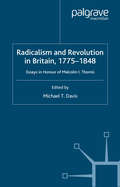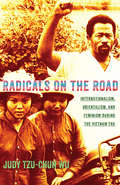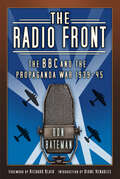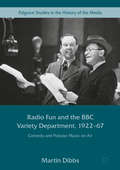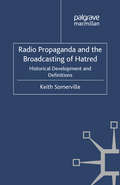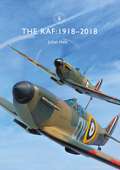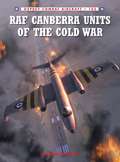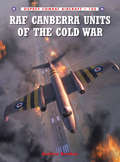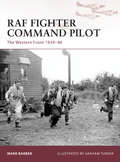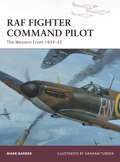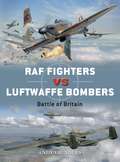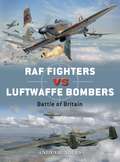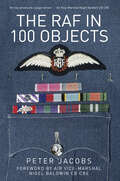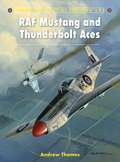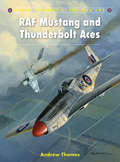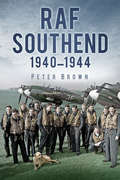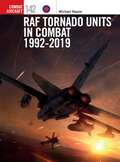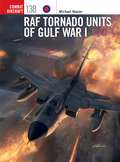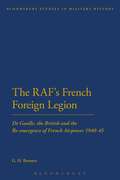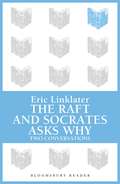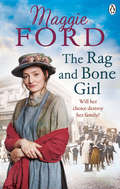- Table View
- List View
Radicalism and Revolution in Britain 1775-1848: Essays in Honour of Malcolm I. Thomis
by M. DavisThe spectre of revolution and the nature of radicalism in Britain from the late eighteenth century through to the age of the Chartists has for some time engaged the interest of scholars and been the topic of much debate. This book honours one of the subject's most renowned and respected historians, Professor Malcolm I. Thomis. In a collection distinguished by its formidable range of contributors, a series of stimulating essays explores and re-examines the threats and ideas of revolution and the byzantine networks and character of British radical culture in the turbulent and intriguing years between 1775 and 1848.
Radicals on the Road: Internationalism, Orientalism, and Feminism during the Vietnam Era (The United States in the World)
by Judy Tzu-Chun WuTraveling to Hanoi during the U.S. war in Vietnam was a long and dangerous undertaking. Even though a neutral commission operated the flights, the possibility of being shot down by bombers in the air and antiaircraft guns on the ground was very real. American travelers recalled landing in blackout conditions, without lights even for the runway, and upon their arrival seeking refuge immediately in bomb shelters. Despite these dangers, they felt compelled to journey to a land at war with their own country, believing that these efforts could change the political imaginaries of other members of the American citizenry and even alter U.S. policies in Southeast Asia. In Radicals on the Road, Judy Tzu-Chun Wu tells the story of international journeys made by significant yet underrecognized historical figures such as African American leaders Robert Browne, Eldridge Cleaver, and Elaine Brown; Asian American radicals Alex Hing and Pat Sumi; Chicana activist Betita Martinez; as well as women’s peace and liberation advocates Cora Weiss and Charlotte Bunch. These men and women of varying ages, races, sexual identities, class backgrounds, and religious faiths held diverse political views. Nevertheless, they all believed that the U.S. war in Vietnam was immoral and unjustified. In times of military conflict, heightened nationalism is the norm. Powerful institutions, like the government and the media, work together to promote a culture of hyperpatriotism. Some Americans, though, questioned their expected obligations and instead imagined themselves as "internationalists," as members of communities that transcended national boundaries. Their Asian political collaborators, who included Buddhist monk Thich Nhat Hanh, Foreign Minister of the Provisional Revolutionary Government Nguyen Thi Binh and the Vietnam Women’s Union, cultivated relationships with U.S. travelers. These partners from the East and the West worked together to foster what Wu describes as a politically radical orientalist sensibility. By focusing on the travels of individuals who saw themselves as part of an international community of antiwar activists, Wu analyzes how actual interactions among people from several nations inspired transnational identities and multiracial coalitions and challenged the political commitments and personal relationships of individual activists.
The Radio Front: The BBC and the Propaganda War 1939-45
by Ron BatemanWithin seventeen years of the first public broadcast in Britain, the nation again found itself at war. As the Second World War progressed, the BBC eventually realised the potential benefits of public radio and the service became vital in keeping an anxious public informed, upbeat and entertained behind the curtains of millions of blacked-out homes. The Radio Front examines just how the BBC reinvented itself and delivered its carefully controlled propaganda to listeners in the UK and throughout Nazi-occupied Europe. It also reveals the BBC’s often-strained relationships with the government, military and public as the organisation sought to influence opinion and safeguard public morale without damaging its growing reputation for objectivity and veracity.Using original source material, historian and author Ron Bateman tracks the BBC’s growth during the Second World War from its unorganised and humble beginnings to the development of a huge overseas and European operation, and also evaluates the importance of iconic broadcasts from the likes of J.B. Priestley, Vera Lynn and Tommy Handley.
Radio Fun and the BBC Variety Department, 1922-67: Comedy and Popular Music on Air (Palgrave Studies in the History of the Media)
by Martin DibbsThis book provides a narrative history of the BBC Radio Variety Department exploring, along chronological lines, the workings of, tensions within and the impact of BBC policies on the programme-making department which generated the organisation’s largest audiences. It provides an insight into key events, personalities, programmes, internal politics and trends in popular entertainment, censorship and anti-American policy as they individually or collectively affected the Department. Martin Dibbs examines how the Department's programmes became markers in the daily and weekly lives of millions of listeners, and helped shape the nation's listening habits when radio was the dominant source of domestic entertainment. The book explores events and topics which, while not directly forming part of the Variety Department’s history, nevertheless intersected with or had an impact on it. Such topics include the BBC’s attitude to jazz and rock and roll, the arrival of television with its impact on radio, the pirate radio stations, and the Popular Music and Gramophone Departments, both of whom worked closely with the Variety Department.
Radio Propaganda and the Broadcasting of Hatred: Historical Development and Definitions
by K. SomervilleAn exposition and analysis of the development of propaganda, focusing on how the development of radio transformed the delivery and impact of propaganda and led to the use of radio to incite hatred and violence.
The RAF: 1918–2018 (Shire Library)
by Julian HaleFor a hundred years the Royal Air Force has been at the forefront of the UK's defences. In the 1920s and 1930s, the RAF protected Britain's empire; during the Second World War it played a key role in defeating the Axis; and through the 1950s and 1960s it was a key part of Britain's nuclear deterrent. Julian Hale examines the history of the RAF through its organisation, personnel, aircraft and campaigns, from the biplanes of the First World War, through its 'Finest Hour' in 1940 and the dawn of the jet age to today's hi-tech aircraft and the emerging role of the unmanned aerial vehicle. Enriched with personal accounts and a wealth of photographs, this book provides a concise introduction to the world's first air force.
The RAF: 1918–2018 (Shire Library #844)
by Julian HaleFor a hundred years the Royal Air Force has been at the forefront of the UK's defences. In the 1920s and 1930s, the RAF protected Britain's empire; during the Second World War it played a key role in defeating the Axis; and through the 1950s and 1960s it was a key part of Britain's nuclear deterrent. Julian Hale examines the history of the RAF through its organisation, personnel, aircraft and campaigns, from the biplanes of the First World War, through its 'Finest Hour' in 1940 and the dawn of the jet age to today's hi-tech aircraft and the emerging role of the unmanned aerial vehicle. Enriched with personal accounts and a wealth of photographs, this book provides a concise introduction to the world's first air force.
RAF Canberra Units of the Cold War (Combat Aircraft)
by Chris Davey Andrew BrookesFrom its first public demonstration at the Farnborough Airshow of 1949, the English Electric Canberra bomber captured the attention of the aviation world. It could outmanoeuvre all the fighters of the time and it could climb way above their operating ceilings. Yet this Cold War equivalent of the Mosquito was simple to maintain and a delight to fly, although it could bite any pilot who did not treat it with respect. The Canberra B 2 first flew on 21 April 1950 and entered frontline service with No 101 Sqn in May 1951. In a testament to the aircraft's benign handling characteristics, the transition programme consisted of only 20 hours in the Gloster Meteor and three hours in the dual-control Canberra trainer. With a maximum speed of 470 knots (871 km/h), a standard service ceiling of 48,000 ft (14,600 m) and the ability to carry a 3.6-tonne (7,900-lb) payload, the Canberra was an instant success.
RAF Canberra Units of the Cold War (Combat Aircraft)
by Chris Davey Andrew BrookesFrom its first public demonstration at the Farnborough Airshow of 1949, the English Electric Canberra bomber captured the attention of the aviation world. It could outmanoeuvre all the fighters of the time and it could climb way above their operating ceilings. Yet this Cold War equivalent of the Mosquito was simple to maintain and a delight to fly, although it could bite any pilot who did not treat it with respect. The Canberra B 2 first flew on 21 April 1950 and entered frontline service with No 101 Sqn in May 1951. In a testament to the aircraft's benign handling characteristics, the transition programme consisted of only 20 hours in the Gloster Meteor and three hours in the dual-control Canberra trainer. With a maximum speed of 470 knots (871 km/h), a standard service ceiling of 48,000 ft (14,600 m) and the ability to carry a 3.6-tonne (7,900-lb) payload, the Canberra was an instant success.
RAF Fighter Command Pilot: The Western Front 1939–42 (Warrior #164)
by Mark BarberThe recent 70th anniversary of the Battle of Britain, combined with the threat of significant cuts to the current RAF, have highlighted the importance of Fighter Command in the early days of World War II once more. The role of the “few”, as described by Churchill, during the Battle of Britain has been the subject of much mythologizing both at the time and in the years since. This title will put Fighter Command in context; describing the lack of funding and attention which it received during the interwar period, until it was almost too late. The myth of the fighter pilot will be humanized, with first-hand accounts quoted which put nervous but brave human beings from all walks of life in the cockpit. Although the Battle of Britain may not have in itself been the decisive encounter that it has historically been portrayed as, the moral victory won by the RAF, the victory that proved that Germany could be defeated, was just as important as a military-strategic victory.
RAF Fighter Command Pilot: The Western Front 1939–42 (Warrior #164)
by Graham Turner Mark BarberThe recent 70th anniversary of the Battle of Britain, combined with the threat of significant cuts to the current RAF, have highlighted the importance of Fighter Command in the early days of World War II once more. The role of the "few†?, as described by Churchill, during the Battle of Britain has been the subject of much mythologizing both at the time and in the years since. This title will put Fighter Command in context; describing the lack of funding and attention which it received during the interwar period, until it was almost too late. The myth of the fighter pilot will be humanized, with first-hand accounts quoted which put nervous but brave human beings from all walks of life in the cockpit. Although the Battle of Britain may not have in itself been the decisive encounter that it has historically been portrayed as, the moral victory won by the RAF, the victory that proved that Germany could be defeated, was just as important as a military-strategic victory.
RAF Fighters vs Luftwaffe Bombers: Battle of Britain (Duel)
by Andy SaundersThe Battle of Britain was a fight for survival against a seemingly unstoppable foe. With the German army poised to invade, only the fighters of the Royal Air Force stood between Hitler and the conquest of Britain. Losses were high on both sides, but the Spitfires, Hurricanes, Havocs and Defiants of the RAF began to take their toll on the overextended, under-protected Kampfgruppen of Heinkel He 111s, Junkers Ju 87s and 88s, and Dornier Do 17s. Both sides learned and adapted as the campaign went on. As the advantage began to shift from the Luftwaffe to the RAF, the Germans were forced to switch from round-the-clock bombing to only launching night-raids, often hitting civilian targets in the dreaded Blitz. This beautifully illustrated study dissects the tactics and technology of the duels in this new kind of war, bringing the reader into the cockpits of the RAF fighters and Luftwaffe bombers to show precisely where the Battle of Britain was won and lost.
RAF Fighters vs Luftwaffe Bombers: Battle of Britain (Duel #68)
by Andy SaundersThe Battle of Britain was a fight for survival against a seemingly unstoppable foe. With the German army poised to invade, only the fighters of the Royal Air Force stood between Hitler and the conquest of Britain. Losses were high on both sides, but the Spitfires, Hurricanes, Havocs and Defiants of the RAF began to take their toll on the overextended, under-protected Kampfgruppen of Heinkel He 111s, Junkers Ju 87s and 88s, and Dornier Do 17s. Both sides learned and adapted as the campaign went on. As the advantage began to shift from the Luftwaffe to the RAF, the Germans were forced to switch from round-the-clock bombing to only launching night-raids, often hitting civilian targets in the dreaded Blitz. This beautifully illustrated study dissects the tactics and technology of the duels in this new kind of war, bringing the reader into the cockpits of the RAF fighters and Luftwaffe bombers to show precisely where the Battle of Britain was won and lost.
The RAF in 100 Objects
by Peter JacobsIt was in the closing year of the First World War, on 1 April 1918, that the Royal Air Force was born from the amalgamation of the Royal Flying Corps and Royal Naval Air Service. Since then, the RAF has helped lead the world in the development of aviation and air warfare. From the fighters and bombers of the Second World War, through the early jet age and into modern remotely piloted air systems, the last hundred years’ development has been astronomical, and the human story no less impressive. Here Peter Jacobs gathers the most poignant objects of the RAF’s proud history and displays them together, in full splendid colour, for the first time. Aircraft, memorials, uniforms, equipment, and some items you would never expect – it’s all here, ready to be explored.
RAF Mustang and Thunderbolt Aces (Aircraft of the Aces #93)
by Chris Davey Andrew ThomasThe P-51 Mustang and P-47 Thunderbolt were the finest American fighters of World War 2, and both saw service with the RAF in substantial numbers. The RAF began flying the Mustang in 1944, using it to fly bomber escort missions, and deploying to support the ground campaigns in Italy and the Balkans. It was also flown by a number of Polish units in the RAF. The P-47 Thunderbolt was the best fighter available in CBI theatre, where it was flown by a number of aces against the Japanese, mainly in a ground support role. Although these two fighter types are most associated with the Americans, they performed an important role serving in the RAF.
RAF Mustang and Thunderbolt Aces (Aircraft Of The Aces Ser. #93)
by Chris Davey Andrew ThomasThe P-51 Mustang and P-47 Thunderbolt were the finest American fighters of World War 2, and both saw service with the RAF in substantial numbers. The RAF began flying the Mustang in 1944, using it to fly bomber escort missions, and deploying to support the ground campaigns in Italy and the Balkans. It was also flown by a number of Polish units in the RAF. The P-47 Thunderbolt was the best fighter available in CBI theatre, where it was flown by a number of aces against the Japanese, mainly in a ground support role. Although these two fighter types are most associated with the Americans, they performed an important role serving in the RAF.
RAF Southend: 1940-1944
by Peter C. BrownRAF Southend focuses in diary-type format on the airport between October 1940 and August 1944, from when it became a fighter station in its own right, to it becoming an armament practice camp later in the war. It describes the manning and maintenance of the forward fighter station, often under attack, and follows the varying fortunes of the staff and personnel who were posted there, and the highs and lows and often tragic events that occurred on and around the aerodrome. It also gives in-depth details of the numerous defensive and offensive operations carried out by the various RAF fighter squadrons while based there. Through interviews with ex-staff and eyewitnesses 'who were there' and the meticulous cross-referencing of original material, it makes for a very accurate and interesting read for people with an interest in local history and/or aviation and military history.
RAF Tornado Units in Combat 1992-2019 (Combat Aircraft)
by Michael NapierAfter the Gulf War of 1990, No Fly Zones (NFZ) were established over northern and southern Iraq and the Tornado GR 1 force stepped up to operations over the southern NFZ. The Tornado GR 4 took responsibility for RAF combat air operations in Afghanistan from the Harrier force in 2009, and in 2011 was involved in missions against the Gaddafi regime in Libya. The unique multirole capabilities of the aircraft enabled it to support ground operations with the Raptor reconnaissance pod, Brimstone missiles and Paveway IV laser-guided bombs until withdrawal in 2014. The Tornado GR 4 was also used for operations over Iraq and Syria against the ISIL terrorist organisation. Intensive air operations were flown between 2014 and 2019, when the Tornado GR 4 was finally withdrawn from RAF Service.This volume, written by former RAF pilot Michael Napier, provides detailed first-hand accounts of the missions undertaken by the Tornado crews during the most recent conflicts over the Middle East and the Balkans.
RAF Tornado Units in Combat 1992-2019 (Combat Aircraft #142)
by Michael NapierAfter the Gulf War of 1990, No Fly Zones (NFZ) were established over northern and southern Iraq and the Tornado GR 1 force stepped up to operations over the southern NFZ. The Tornado GR 4 took responsibility for RAF combat air operations in Afghanistan from the Harrier force in 2009, and in 2011 was involved in missions against the Gaddafi regime in Libya. The unique multirole capabilities of the aircraft enabled it to support ground operations with the Raptor reconnaissance pod, Brimstone missiles and Paveway IV laser-guided bombs until withdrawal in 2014. The Tornado GR 4 was also used for operations over Iraq and Syria against the ISIL terrorist organisation. Intensive air operations were flown between 2014 and 2019, when the Tornado GR 4 was finally withdrawn from RAF Service.This volume, written by former RAF pilot Michael Napier, provides detailed first-hand accounts of the missions undertaken by the Tornado crews during the most recent conflicts over the Middle East and the Balkans.
RAF Tornado Units of Gulf War I (Combat Aircraft)
by Michael NapierWhen the Gulf Crisis of 1990 was triggered by the Iraqi invasion of Kuwait, the RAF responded by sending Tornado F 3 fighters to Saudi Arabia to help defend the country against further aggression. These aircraft were followed by the deployment of Tornado GR 1 strike/attack aircraft to Bahrain. Eventually three wings of Tornado GR 1s were established in Bahrain, Tabuk and Dhahran, as well as a detachment of Tornado GR 1A reconnaissance aircraft. At the start of hostilities in January 1991, the Tornado GR 1 wings carried out night-low-level attacks against Iraqi Main Operating Bases using the JP233 runway denial weapon. Meanwhile, Combat Air Patrols from the Tornado F 3 wing ensured the integrity of Saudi airspace.Once air supremacy had been established, the Tornado GR 1 force moved to medium-level operations, initially by night and later by day, to attack the Iraqi oil production and storage infrastructure. The arrival in theatre of a laser designation capability with Pave Spike/Buccaneer and TIALD/Tornado enabled precision attacks against the Iraq transport system to cut off the frontline troops from resupply and reinforcement and then to carry out a systematic destruction of the airfield facilities. Tornado GR 1A reconnaissance operations played a major role in the location of Scud missile launchers and in the planning and execution of the land offensive. Throughout the conflict, the Tornado F 3 wing at Dhahran carried out defensive counter-air operations to ensure the safety of the base areas. This volume, publishing 30 years after the conflict to free Kuwait, provides detailed first-hand accounts of the missions undertaken by the Tornado crews. It is illustrated by photographs taken by aircrew involved in the operation and includes 30 newly commissioned profile artworks and detailed nose art views of the aircraft ranged against Iraq.
RAF Tornado Units of Gulf War I (Combat Aircraft)
by Michael NapierWhen the Gulf Crisis of 1990 was triggered by the Iraqi invasion of Kuwait, the RAF responded by sending Tornado F 3 fighters to Saudi Arabia to help defend the country against further aggression. These aircraft were followed by the deployment of Tornado GR 1 strike/attack aircraft to Bahrain. Eventually three wings of Tornado GR 1s were established in Bahrain, Tabuk and Dhahran, as well as a detachment of Tornado GR 1A reconnaissance aircraft. At the start of hostilities in January 1991, the Tornado GR 1 wings carried out night-low-level attacks against Iraqi Main Operating Bases using the JP233 runway denial weapon. Meanwhile, Combat Air Patrols from the Tornado F 3 wing ensured the integrity of Saudi airspace.Once air supremacy had been established, the Tornado GR 1 force moved to medium-level operations, initially by night and later by day, to attack the Iraqi oil production and storage infrastructure. The arrival in theatre of a laser designation capability with Pave Spike/Buccaneer and TIALD/Tornado enabled precision attacks against the Iraq transport system to cut off the frontline troops from resupply and reinforcement and then to carry out a systematic destruction of the airfield facilities. Tornado GR 1A reconnaissance operations played a major role in the location of Scud missile launchers and in the planning and execution of the land offensive. Throughout the conflict, the Tornado F 3 wing at Dhahran carried out defensive counter-air operations to ensure the safety of the base areas. This volume, publishing 30 years after the conflict to free Kuwait, provides detailed first-hand accounts of the missions undertaken by the Tornado crews. It is illustrated by photographs taken by aircrew involved in the operation and includes 30 newly commissioned profile artworks and detailed nose art views of the aircraft ranged against Iraq.
The RAF's French Foreign Legion: De Gaulle, the British and the Re-emergence of French Airpower 1940-45 (Bloomsbury Studies in Military History)
by G. H. BennettThis book examines and analyses the relationship between the RAF, the Free French Movement and the French fighter pilots in WWII. A highly significant subject, this has been ignored by academics on both sides of the Channel. This ground-breaking study will fill a significant gap in the historiography of the War. Bennett's painstaking research has unearthed primary source material in both Britain and France including Squadron records, diaries, oral histories and memoirs. In the post-war period the idea of French pilots serving with the RAF seemed anachronistic to both sides. For the French nation the desire to draw a veil over the war years helped to obscure many aspects of the past, and for the British the idea of French pilots did not accord with the myths of "the Few" to whom so much was owed. Those French pilots who served had to make daring escapes. Classed as deserters they risked court martial and execution if caught. They would play a vital role on D-Day and the battle for control of the skies which followed.
The RAF's French Foreign Legion: De Gaulle, the British and the Re-emergence of French Airpower 1940-45 (Bloomsbury Studies in Military History)
by G. H. BennettThis book examines and analyses the relationship between the RAF, the Free French Movement and the French fighter pilots in WWII. A highly significant subject, this has been ignored by academics on both sides of the Channel. This ground-breaking study will fill a significant gap in the historiography of the War. Bennett's painstaking research has unearthed primary source material in both Britain and France including Squadron records, diaries, oral histories and memoirs. In the post-war period the idea of French pilots serving with the RAF seemed anachronistic to both sides. For the French nation the desire to draw a veil over the war years helped to obscure many aspects of the past, and for the British the idea of French pilots did not accord with the myths of "the Few" to whom so much was owed. Those French pilots who served had to make daring escapes. Classed as deserters they risked court martial and execution if caught. They would play a vital role on D-Day and the battle for control of the skies which followed.
The Raft and Socrates Asks Why
by Eric LinklaterAre the people of Britain capable of serving the new world, of writing with honour a new chapter of history? The answer, conclusively, is Yes.… But Socrates, in the third of the pieces, has still to be satisfied that the Allies are truly conscious of their purpose. A four-fold rule of law is not enough: the peace within that rule must not be an idle peace, but creative. If that is not explicitly our intention and desire, then why are we fighting? The Raft and Socrates Asks Why are imaginary conversations revolving around the political and military problems of WWII. The Raft is set in the mid-Atlantic, where six survivors from a torpedoed ship discuss the position of Britain and the difficulties and moral dilemmas of a soldier life. Socrates Asks Why is a conversation between Socrates, Voltaire, Johnson and Lincoln where the Allies' aim of peace and ending of the war is discussed and questioned. These conversations were first published in 1942.
The Rag and Bone Girl
by Maggie FordWhat will she sacrifice for love? Growing up in London’s East End with six siblings, Nora Taylor has always been close to her younger sister Maggie. But when she meets Maggie’s fiancé Robert, they are immediately drawn to each other. Forced to choose between her family and her heart, Nora decides to marry the man she loves – even if it means losing her sister.When the First World War breaks out, Nora must fight to hold her family together through the challenges and tragedies to come. As her children grow up they embark on their own adventures, but another war will threaten all their hopes for the future. Can this broken family survive the dark days of wartime?A sweeping saga charting one family’s fortunes through the First and Second World War and beyond, perfect for fans of Maggie Hope and Dilly Court.
